Physical Address
304 North Cardinal St.
Dorchester Center, MA 02124
A solid tumor is an organ composed of neoplastic cells and stromal cells including immune cells nourished by vasculature made of endothelial cells—all embedded in an extracellular matrix. The interactions among these cells, their surrounding matrix, and their local microenvironment control the expression of various genes. The products encoded by these genes, in turn, control the pathophysiologic characteristics of the tumor. Tumor pathophysiology governs not only tumor growth, invasion, and metastasis but also the response to various therapies.
Tumor vasculature is made of host vessels co-opted by tumor cells and by new vessels formed by the processes of vasculogenesis and angiogenesis. A constellation of positive and negative regulators of angiogenesis governs the process of neovascularization.
Tumor vessels are abnormal in terms of their organization, structure, and function. These abnormalities contribute to heterogeneity in vascular permeability, blood flow, and the microenvironment.
Tumor interstitial matrix is formed of proteins secreted by host and tumor cells and by those leaked from the nascent blood vessels.
Tumor interstitium is heterogeneous, with some regions fairly permeable and others difficult to penetrate. Modification of collagen and hyaluronan in the matrix can improve penetration of large-molecular-weight therapeutics.
Solid components of tumors—cancer cells, stromal cells, and matrix molecules—mechanically compress blood and lymphatic vessels, resulting in reduced perfusion that limits oxygen and drug supply. Reducing these constituents decompresses blood vessels to enhance perfusion and drug delivery.
Interstitial hypertension results from vessel leakiness, lack of functional lymphatics, and compression of blood and lymphatic vessels by proliferating cancer cells. Interstitial hypertension cannot compress leaky vessels, because the intravascular and extravascular fluid pressures equilibrate.
Judicious application of angiogenic therapy can normalize the tumor vessels and make them more efficient for delivery of oxygen (a known radiosensitizer) and drugs. Indeed, clinical studies indicate that antiangiogenic agents can increase perfusion and oxygenation in tumors, and that these effects are associated with improved response.
Twelve antiangiogenic agents have been approved for cancer. Two main goals to improve patient outcomes with antiangiogenic agents are the development of therapies that fortify vessels without pruning and verification of biomarkers predictive of response. Additionally, the potential of combining antiangiogenic and solid stress–alleviating therapies with immunotherapies should be confirmed in clinical trials.
A solid tumor is an organ composed of neoplastic cells and host stromal cells including resident and transiting immune cells nourished by the vasculature made of endothelial cells (ECs)—all embedded in an extracellular matrix ( Fig. 8.1 ). The interactions among these cells and between these cells, their surrounding matrix, and their local microenvironment, control the expression of various genes. The products encoded by these genes, in turn, control the pathophysiologic characteristics of the tumor. Tumor pathophysiology governs not only tumor growth, invasion, and metastasis but also the response to various therapies. In this chapter we will discuss various pathophysiologic parameters that characterize the vascular and extravascular compartments of a tumor and the mechanisms governing the formation and function of these compartments.
Neoplastic cells, like normal cells, need oxygen and other nutrients for their survival and growth. Every normal cell in the human body is located within 100 to 200 µm of a blood capillary so that it can receive oxygen and other nutrients by the process of diffusion. Likewise, cells undergoing neoplastic transformation depend on nearby capillaries for growth. These preneoplastic (i.e., hyperplastic or dysplastic) cells can grow as a spherical or ellipsoidal cellular aggregate. Once the size of the cellular aggregate reaches the diffusion limit for critical nutrients and oxygen, however, the aggregate as a whole can become dormant. Indeed, human tumors can remain dormant for many years because of a balance between neoplastic cell proliferation and apoptosis. However, once they have access to new blood vessels, they may grow and metastasize. What triggers the growth of new vessels? What molecular and cellular mechanisms are involved? How do these vessels compare with normal vessels with respect to structure and function? Can we prevent or delay tumor progression only by interfering with the neovascularization process?
It has been known for nearly a century that the vascular system is associated with tumor growth in animals and humans. Powerful insights into the neovascularization of transplanted tumors using the transparent window techniques were developed in the 1940s. The possibility that tumors produce an “angiogenic” substance was suggested in 1968. The hypothesis that blocking angiogenesis should block tumor growth and metastasis was proposed shortly thereafter in 1971. The concept that a tissue acquires angiogenic capacity during neoplastic transformation—and, by extension, that antiangiogenesis could be used to prevent cancer—was put forward in 1978. The first antiangiogenic agent approved for cancer patients was bevacizumab, an antibody specific to vascular endothelial growth factor (VEGF), on the basis of the increased survival seen in metastatic colorectal cancer patients with the combination of bevacizumab with standard chemotherapy in a pivotal randomized placebo-controlled phase III trial. At present, various antiangiogenesis and proangiogenesis strategies are being evaluated clinically to prevent or treat a large number of diseases, including cancer. Both normal and pathologic angiogenic processes are governed by the net balance between proangiogenic and antiangiogenic factors. This balance is spatially and temporally regulated under physiologic conditions, so that the “angiogenic switch” is “on” when needed (e.g., during embryonic development, wound healing, formation of the corpus luteum) and “off” at other times. During neoplastic transformation and tumor progression, this regulation is deranged, and blood vessels form ectopically to support a growing tumor mass.
At least four cellular mechanisms are involved in the vascularization of tumors: co-option, intussusception, sprouting (angiogenesis), and vasculogenesis ( Fig. 8.2 ). Tumor cells can co-opt and grow around existing vessels to form “perivascular” cuffs. However, as stated earlier, these cuffs cannot grow beyond the diffusion limit of critical nutrients and may actually cause the collapse of the vessels owing to growth pressure (referred to as “solid stress”). Alternatively, an existing vessel may enlarge in response to the growth factors released by tumors, and an interstitial tissue column may grow in the enlarged lumen and partition the lumen to form an expanded vascular network. This mode of intussusceptive microvascular growth has been observed during tumor growth, wound healing, and gene therapy. “Sprouting” angiogenesis is perhaps the most widely studied mechanism of vessel formation. During sprouting angiogenesis, the existing vessels become leaky in response to growth factors released by normal cells or cancer cells; the basement membrane and the interstitial matrix dissolve; pericytes dissociate from the vessel; ECs migrate and proliferate to form an array or sprout; a lumen is formed in the sprout (a process referred to as canalization); branches and loops are formed by confluence and anastomoses of sprouts to permit blood flow; and finally, these immature vessels are invested with basement membrane and pericytes. During physiologic angiogenesis, these vessels differentiate into mature arterioles, capillaries, and venules, whereas in tumors they remain largely immature. During embryonic development, a primitive vascular plexus is formed from endothelial precursor cells (EPCs, also known as angioblasts) by a process referred to as vasculogenesis. In adults, EPCs—mobilized from bone marrow niches into the peripheral blood circulation—can also contribute to neovascularization (a process referred to as postnatal vasculogenesis) in tumors and other tissues. In addition, reports have demonstrated that a fraction of ECs in tumor vessels may be derived via transdifferentiation from cancer cells, or from cancer stem-like cells (e.g., in glioblastomas [GBMs]). In this larger context, the term vasculogenesis might be invoked to describe neovascularization in tumors from tumor stem cells. Tumor vasculogenesis may also occur from EPCs of non–bone marrow origin that are recruited from adjacent tissues and/or circulation. The current challenge is to discern the relative contribution of each of these mechanisms of neovascularization during tumor growth, and during and after treatment of tumors.
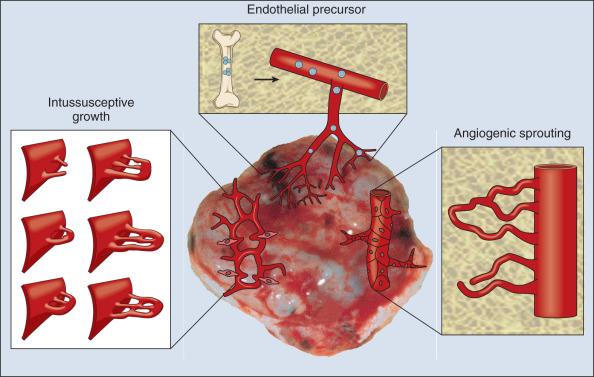
Various proangiogenic and antiangiogenic molecules that orchestrate different steps in vessel formation, along with their functions, are listed in Table 8.1 . VEGF is currently considered the most critical proangiogenic molecule. Originally discovered in 1983 as the vascular permeability factor and cloned in 1989, VEGF increases vascular permeability, promotes migration and proliferation of ECs, serves as an EC survival factor, can mobilize EPC populations from the bone marrow, and is known to upregulate leukocyte adhesion molecules on ECs. During tumor progression, or with treatment, the number of distinct angiogenic molecules produced by a tumor can increase. Thus, after VEGF signaling is blocked, a tumor might rely on other, alternative angiogenic molecules (e.g., basic fibroblast growth factor [bFGF], stromal-derived factor 1α [SDF1α], placental-derived growth factor [PlGF], or interleukin-8 [IL-8]). Other positive regulators of angiogenesis include the angiopoietins that are involved in stabilizing vessels and controlling vascular permeability; various proteases involved in dissolving and remodeling matrix and releasing growth factors; and organ-specific angiogenic stimulators (e.g., endocrine gland VEGF). Angiogenesis inhibitors include endogenous soluble receptors of various proangiogenic ligands (e.g., sVEGFR1/sFLT1) and molecules that downregulate the expression of stimulators (e.g., interferons) or that interfere with the release of the stimulators or binding with their receptors (e.g., platelet factor 4). Thrombospondins are among the first and best characterized endogenous inhibitors that interfere with the growth, adhesion, migration, and survival of ECs. Other endogenous inhibitors include fragments of various plasma or matrix proteins (e.g., angiostatin, a fragment of plasminogen; endostatin, a fragment of collagen XVIII; tumstatin, a fragment of collagen IV). Neither the mechanisms of action of the matrix-derived inhibitors nor their physiologic role is well understood. The generation of proangiogenic and antiangiogenic molecules can be triggered by metabolic stress (e.g., low P o 2 , low pH, or hypoglycemia), mechanical stress (e.g., shear stress, solid stress), immune or inflammatory cells that have infiltrated the tissue, and genetic mutations (e.g., activation of oncogenes or deletion of suppressor genes that control the production of angiogenesis regulators). These molecules can emanate from cancer cells, ECs, stromal cells, blood, and extracellular matrix ( Fig. 8.3 ). Because the normal host cells differ among organs, the detailed mechanisms of angiogenesis might depend on the specific host-tumor interactions operating within a given tissue. Furthermore, because the tumor microenvironment is likely to change during tumor growth, regression, and relapse, profiles of proangiogenic and antiangiogenic molecules are likely to change with time and space. The challenge currently is to develop a unified conceptual framework to describe the temporal and spatial profiles of this increasingly diverse array of angiogenesis regulators with the aim of developing effective therapeutic strategies.
| Activators | Function | Inhibitors | Function |
|---|---|---|---|
| VEGF family members b,c | Stimulate angiogenesis and vasculogenesis, permeability, leukocyte adhesion | VEGFR1; soluble VEGFR1; soluble neuropilin-1 (NRP-1) | Sink for VEGF, VEGF-B, PlGF |
| VEGFR c , NRP-1, NRP-2 | Integrate angiogenic and survival signals | Ang 2 b,c | Antagonist of Ang 1 |
| EG-VEGF | Stimulate growth of endothelial cells derived from endocrine glands | TSP-1,2 | Inhibit endothelial migration, growth, adhesion, and survival |
| Ang 1 and Tie 2 b,c | Stabilize vessels | Angiostatin and related plasminogen kringles | Inhibit endothelial migration and survival |
| PDGF-BB and receptors | Recruit smooth muscle cells | Endostatin (collagen XVIII fragment) | Inhibit endothelial survival and migration |
| TGF-β1 d , endoglin, TGF-β receptors | Stimulate extracellular matrix production | Tumstatin (collagen IV fragment) | Inhibit endothelial protein synthesis |
| FGF, HGF, MCP-1 | Stimulate angio/arteriogenesis | Vasostatin; calreticulin | Inhibit endothelial growth |
| Integrins α v β 3 , α v β 5 , α 5 β 1 | Receptors for matrix macromolecules and proteinases | Platelet factor 4 | Inhibit binding of bFGF and VEGF |
| VE-cadherin; PECAM (CD31) | Endothelial junctional molecules | Tissue inhibitors of MMP (TIMPs); MMP inhibitors; PEX | Suppress pathologic angiogenesis |
| Ephrins c | Regulate arterial and venous specification | Meth-1; Meth-2 | Inhibitors containing MMP-, TSP-, and disintegrin domains |
| Plasminogen activators, MMPs | Remodel matrix, release growth factor | IFN-α, IFN-β, IFN-γ; IP-10, IL-4, IL-12, IL-18 | Inhibit endothelial migration; downregulate bFGF |
| PAI-1 | Stabilize nascent vessels | Prothrombin kringle-2; antithrombin III fragment | Suppress endothelial growth |
| NOS; COX-2 | Stimulate angiogenesis and vasodilation | 16 kD-prolactin | Inhibit bFGF/VEGF |
| AC133 | Regulate angioblast differentiation | VEGI | Modulate cell growth |
| Chemokines d | Pleiotropic role in angiogenesis | Fragment of SPARC | Inhibit endothelial binding and activity of VEGF |
| Id1/Id3 | Inhibit differentiation | Osteopontin fragment Maspin, canstatin, proliferin-related protein, restin |
Interfere with integrin signaling Protease inhibitor Mechanisms unknown |
a Selected list updated from Carmeliet P, Jain RK. Molecular mechanisms and clinical applications of angiogenesis. Nature. 2011;473:298–307 ; for complete function and references, see supplementary information ( http://steele.mgh.harvard.edu ).
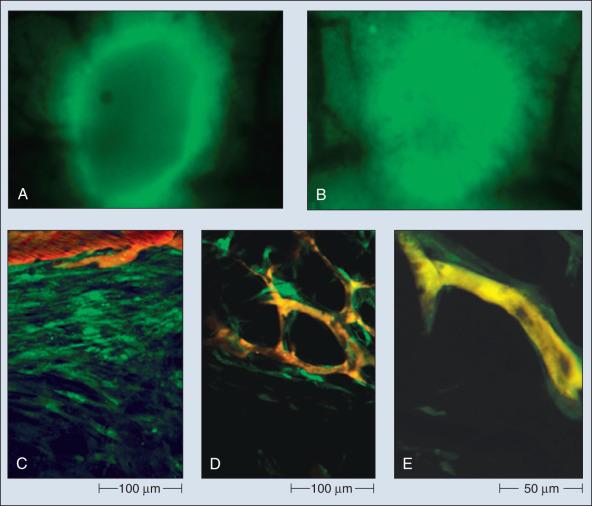
In a normal tissue, blood flows from an artery to arterioles to capillaries to venules to a vein. Although the tumor vasculature originates from these host vessels and the mechanisms of angiogenesis are similar, its organization may differ dramatically, depending on the tumor type, its location, and whether it is growing, regressing, or relapsing. In general, tumor vessels are dilated, saccular, tortuous, and chaotic in their patterns of interconnection. For example, whereas normal vasculature is characterized by dichotomous branching, tumor vasculature has many trifurcations and branches with uneven diameters. The fractal dimensions and minimum path lengths of tumor vasculature are different from those of normal host vasculature. The molecular mechanisms of this abnormal vascular architecture are not understood, but it seems reasonable to hypothesize that the imbalance of VEGF and angiopoietins is a key contributor. In mice, “normalization” of the tumor vasculature observed during treatment with therapies that reduce VEGF (e.g., hormone withdrawal from a hormone-dependent tumor), interfere with VEGF signaling (e.g., treatment with anti-VEGF or anti-VEGFR2 antibody; Fig. 8.4 ), or mimic an antiangiogenic cocktail (e.g., trastuzumab [Herceptin] treatment of a HER2-overexpressing tumor) is in concert with this molecular hypothesis. Mechanical stress generated by proliferating cancer and stromal cells and their excessive interstitial matrix production also can lead to the partially compressed or totally collapsed vessels often found in tumors ( Fig. 8.5A–B ). The decompression of blood vessels observed after induction of apoptosis in perivascular cells or stromal cells, or enzymatic degradation of matrix hyaluronan, supports this mechanical hypothesis ( Fig. 8.5C ). Perhaps the combination of both molecular and mechanical factors renders the tumor vasculature abnormal, and thus both types of factors must be taken into account in designing novel strategies for cancer treatment.
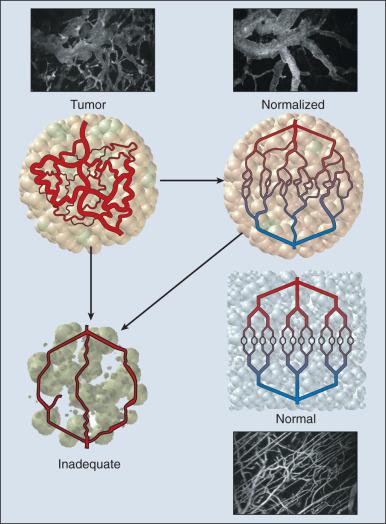
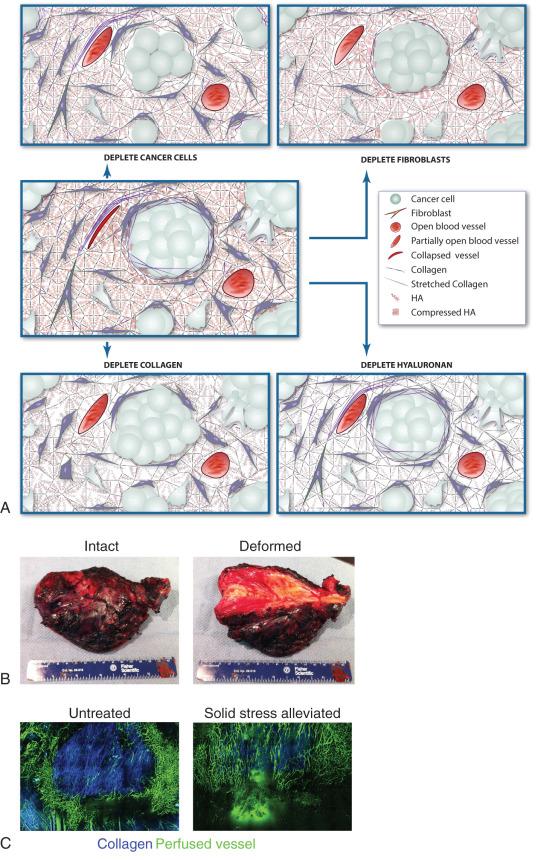
Blood flow in a vascular network, whether normal or abnormal, is governed by the arteriovenous pressure difference and flow resistance. Flow resistance is a function of the vascular architecture (referred to as geometric resistance) and of the blood viscosity (rheology, referred to as viscous resistance). Abnormalities in both vasculature and viscosity increase the resistance to blood flow in tumors. As a result, overall perfusion rates (blood flow rate per unit volume) in tumors are lower than in many normal tissues. Both macroscopically and microscopically, tumor blood flow is temporally and spatially chaotic. Macroscopically, four spatial regions can be recognized in a tumor ( Fig. 8.6 ):
An avascular necrotic region
A seminecrotic region
A stabilized microcirculation region
An advancing front
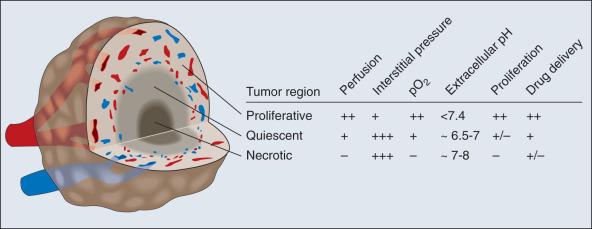
At the microscopic level, in normal tissues, erythrocyte velocity is dependent on vessel diameter, but there is no such dependence in most tumors. Furthermore, the average erythrocyte velocity can be an order of magnitude lower in some tumors as compared with that of normal host tissue ( Fig. 8.7 ). In a given vessel within a tumor, blood flow fluctuates with time and can reverse its direction. In addition to the elevated geometric and viscous (rheologic) resistance, other molecular and mechanical factors contribute to this spatial and temporal heterogeneity. These include imbalance between proangiogenic and antiangiogenic molecules, solid stress generated by proliferating tumor cells and matrix production, vascular remodeling by intussusception, and coupling between luminal and interstitial fluid pressure (IFP) via hyperpermeability of tumor vessels. As will be discussed later, this heterogeneity contributes to both acute and chronic hypoxia in tumors—a major cause of resistance to radiation and other therapies. Increased perfusion also correlates with a positive response to radiotherapy or chemotherapy and patient survival. Considerable effort has gone into increasing tumor blood flow for improving radiation therapy, or decreasing tumor perfusion in the case of hyperthermia. This has been difficult to achieve reproducibly, because tumor vasculature consists of both vessels co-opted from the preexisting host vasculature and vessels resulting from the angiogenic response of host vessels to cancer cells. The former are invested in normal contractile perivascular cells, whereas the latter lack these perivascular cells or these cells are abnormal. Presumably as a result, efforts to increase the tumor blood flow with pharmacologic or physical agents have not always been reproducible or successful. On the other hand, the strategy of decreasing or shutting down the tumor blood flow—by “stealing” blood away from the “passive component” of the tumor vasculature with vasodilators, through vascular targeting, or by means of intravascular coagulation—has shown promise in experimental systems. It also appears that judiciously applied antiangiogenic therapy could “normalize” the abnormal tumor microcirculation by pruning the immature vessels (see Fig. 8.4 ), thus rendering the remaining vasculature more responsive to vasoactive agents.
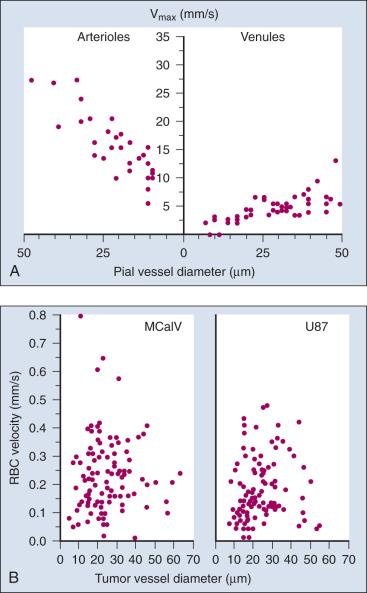
Once a blood-borne molecule has reached an exchange vessel, its extravasation occurs by diffusion, convection, and, to some extent, presumably by transcytosis. The effective permeability, P, of a molecule depends on the size, shape, charge, and flexibility of the molecule, and on the size, shape, charge, and dynamics of the transvascular transport pathway. In normal vessels, these pathways include diffusion along the EC membrane (for lipophilic solutes), trans-EC diffusion, interendothelial junctions (<7 nm), open or closed fenestrations (<10 nm), and transendothelial channels (including vesicles or vesicovacuolar channels). Some of these anatomic pathways may be lined with glycocalyx on EC, thus effectively reducing the size of the pathway. A basement membrane may further retard the movement of molecules. Ultrastructure studies show widened interendothelial junctions, increased numbers of fenestrations, vesicles, and vesicovacuolar channels in tumor vessels, and a lack of normal basement membrane and pericytes. In concert with these ultrastructural findings, both vascular permeability and hydraulic conductivity (a measure of water movement by pressure gradient) of tumors, in general, are significantly higher than those for various normal tissues. Furthermore, unlike normal vessels in the surrounding tissue, tumor vessels partially lose molecular size–based selectivity in permeability to different molecules. Despite increased overall permeability, not all blood vessels of a tumor are leaky ( Fig. 8.8A ). Even the leaky vessels have a finite pore size that is tumor dependent ( Fig. 8.8B ), and ultrastructural studies have shown that the larger pore size in tumors represents wide interendothelial junctions. Thus permeability is inversely related to molecular size because of steric and hydrodynamic hindrance from these pores, and very large molecules, such as nanoparticles, do not penetrate tumors efficiently. Molecular shape also influences penetration of these pores, such that rod-shaped molecules have a higher permeability than spherical molecules. Similarly, positively charged molecules have a higher affinity for the negatively charged glycocalyx in the pores of these angiogenic tumor vessels, reducing this hindrance and giving them a higher permeability. Not only do the vascular permeability and pore size vary from one tumor to the next (see Fig. 8.8A–C ), but within the same tumor they vary spatially and temporally, as they do during tumor growth, regression, and relapse. The local microenvironment plays an important role in controlling vascular permeability (see Fig. 8.8D ). For example, a human glioma (HGL21) has fairly leaky vessels when grown subcutaneously in immunodeficient mice, but it exhibits blood-brain barrier properties in the brain. Such site-dependent differences for other tumors have been observed in other orthotopic sites. One possible explanation is that the host-tumor interactions control the production and secretion of cytokines associated with permeability increase (e.g., VEGF) and decrease (e.g., angiopoietin 1). A better understanding of the molecular mechanisms of permeability regulation in tumors is likely to yield strategies for improved delivery of molecular medicine to tumors.
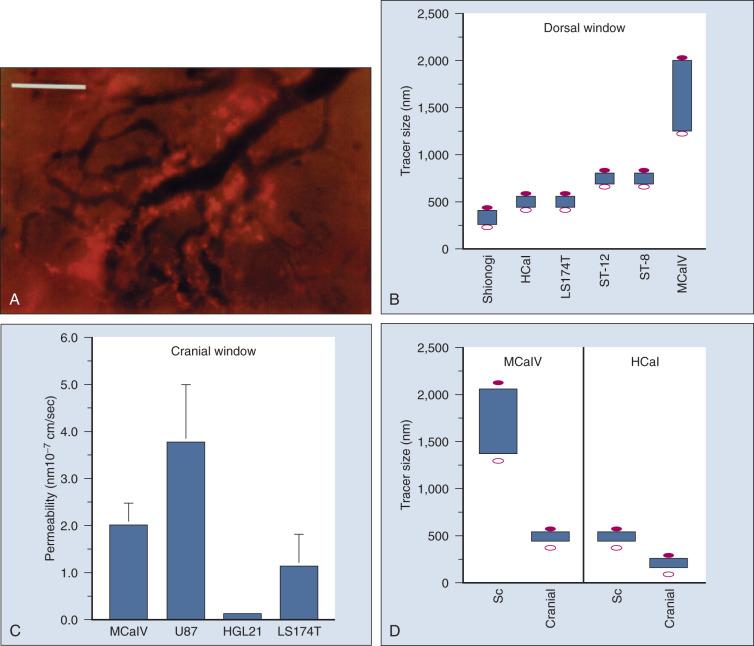
Both cancer cells and immune cells frequently move across the walls of blood vessels—the former in the process of metastasis, and the latter during immune response or cell-based immunotherapy. Both transendothelial (through ECs) and periendothelial (between ECs) pathways have been proposed as a route for intravasation and extravasation of cells. Very little is known about intravasation except that tumors might shed more than a million cells per gram per day, and most of these are not clonogenic. We have demonstrated that metastatic cells could bring their own stroma from the primary tumor in the form of heterotypic cell clumps. More is known about the molecular and cellular mechanisms of extravasation. When a cell enters a blood vessel, it can continue to move with the flowing blood, collide with the vessel wall, adhere transiently or stably, and finally extravasate. These interactions are governed by both local hydrodynamic forces and adhesive forces. The former are determined by the vessel diameter and fluid velocity, and the latter by the expression, strength, and kinetics of bond formation between adhesion molecules and by the surface area of contact. Deformability of cells affects both types of forces. In addition, cancer cells may grow intravascularly at the distant site (e.g., in the lungs).
Rolling of endogenous leukocytes is generally low in tumor vessels, whereas stable adhesion (≥30 seconds) is comparable between normal vessels and tumor vessels. On the other hand, both rolling and stable adhesion are nearly zero in angiogenic vessels induced in collagen gels by bFGF or VEGF, two of the most potent angiogenic factors. Whether this observation is due to a low flux of leukocytes into angiogenic vessels and/or to downregulation of adhesion molecules in these immature vessels is currently not known. The age of the animal also plays an important role in leukocyte-endothelial interactions. Further insight into the types of cells that adhere to tumor vessels comes from studies on the localization of IL-2–activated natural killer (A-NK) cells in normal and tumor tissues in mice in which positron emission tomography was used. After systemic injection, these cells localized primarily in the lungs immediately after injection and could not be detected in the tumor. Increased rigidity caused by IL-2 activation might contribute to the mechanical entrapment of these cells in the lung microcirculation. Constitutive expression of certain adhesion molecules in the lung vasculature might also facilitate their retention in the lungs. One approach to reducing lung entrapment is to reduce the rigidity of these cells. Alternatively, the lung can be circumvented by injecting A-NK cells directly into the blood supply of tumors. In this case, A-NK cells, both xenogeneic and syngeneic, adhered to some blood vessels in three different tumor models via CD18 and very large antigen 4 (VLA-4) on the A-NK cells and intercellular adhesion molecule 1 (ICAM-1), vascular cell adhesion molecule 1 (VCAM-1), and E-selectin on the activated endothelium of angiogenic vessels. These molecules can be upregulated by tumor necrosis factor-α (TNF-α) and a protein of 90 kd molecular weight (p90) that is secreted by some neoplastic cells and downregulated by transforming growth factor-β (TGF-β)—also, presumably, secreted by cancer cells. Surprisingly, the proangiogenic VEGF also can upregulate these molecules, whereas another proangiogenic molecule, bFGF, can downregulate these molecules. On the other hand, inflammatory cells such as monocytes and macrophages or neutrophils are also recruited by VEGF and may play important roles in promoting matrix remodeling and angiogenesis. The challenge currently is to decrease nonspecific entrapment of immune cells in normal vessels and to increase their delivery to tumor vessels to improve various cell-based therapies, including gene therapy.
Become a Clinical Tree membership for Full access and enjoy Unlimited articles
If you are a member. Log in here